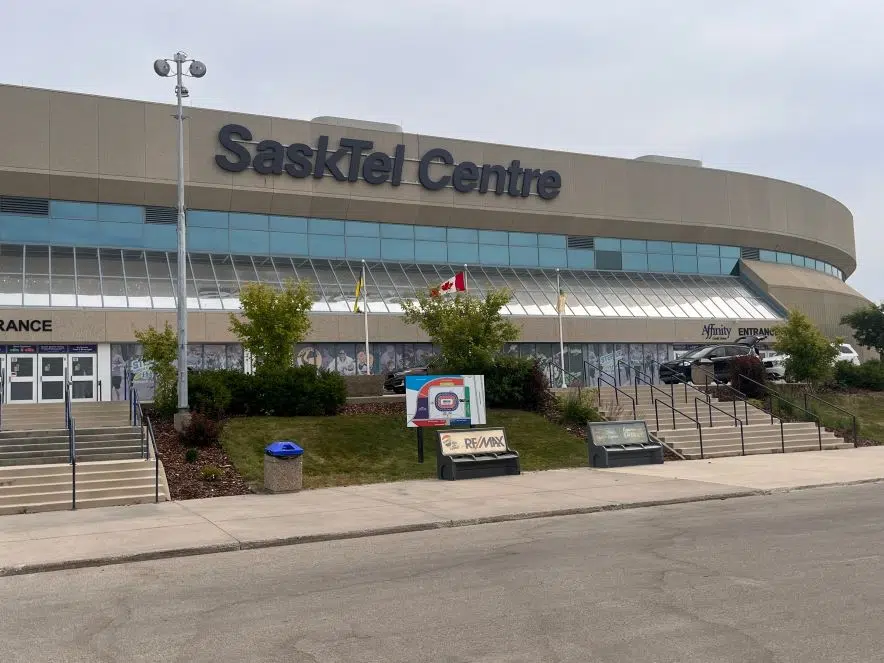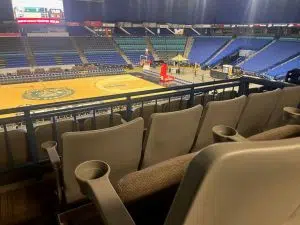While Saskatoon considers a new downtown arena, the shortcomings of the city’s current facility are being put under the spotlight.
Public tours of SaskTel Centre on Monday, advertised as an “explore behind the scenes” event, highlighted what CEO John Howden said were tens of millions of dollars in necessary building upgrades, outdated operational systems, and how a new arena could benefit the city.
According to Howden, about 200 people toured the facility Monday. Each tour lasted about 90 minutes, beginning in the lobby and continuing throughout the main concourse to the upper levels of the arena, before concluding in the basement of the arena, where food and catering operations are housed.
“When people are making their buying decisions to come to concerts and events, there’s compromises that they have to make, especially when they come to a building like ours,” Howden said.
The CEO said some of those compromises include patrons waiting in lines outside the building during the winter months as bags and tickets were checked prior to admittance for hockey games, concerts and other events.
“For maybe a million dollars, we could probably put a bigger entry on the outside so the people wouldn’t have to stand outside. (That) would be a lot cheaper than building a new arena, wouldn’t it?” asked one tour patron.
In response, Howden said a million dollars here and a million dollars there starts to add up quickly.
“Eventually, you’re at $100 million plus. How do you make the concourses wider? How do you add more concession stands and all the things a modern facility would have? And that’s what we’re comparing ourselves to,” responded Howden.
When SaskTel Centre opened its doors in 1988, there were 7,800 seats in the building. Over the years more seats were added, until eventually there were 15,100 seats, with 51 luxury suites. Those suites alone bring in about $2 million per year, and last year SaskTel Centre made $1.5 million in profits.
Howden spoke about a shortage of public restroom facilities, the lack of accessible seating options for those who have mobility challenges, 10,000 seats in the upper portion or “cheaper ticket” portion of the building – twice as many as in the lower portion, which typically has the more expensive seating – only one elevator in the building, not enough room for catering facilities, difficulty keeping the building cool in the summer and a lack of rigging options and loading bays for event equipment, Vegas-style concerts, and even deliveries.
All of those issues combined meant Saskatoon was consistently losing out on trade shows, concerts and other big events, Howden explained. He cited Edmonton’s Rogers Place as the standard to which Saskatoon aspired.
“People are saying ‘Well, SaskTel Centre is great the way it is. We don’t need to do anything. I don’t know what people are talking about.’ Our job is to say, ‘It might look good if you come in as a guest, but what happens behind the scenes that we compromise on to get these shows to come here isn’t necessarily acceptable anymore.’
“And I think a lot of fans would say, ‘You know what? I would like better amenities when I come to an event.’ In a modern facility, that’s what you’d get,” the CEO explained.
At the end of the day, Howden said it is the actual structure of the building that is hampering progress.
“The concert tours aren’t coming because they can’t sell the tickets,” he added.
That said, at least $2 million has been spent over the last couple of years on upgrading the building, adding things like additional food and wine bars, a “grab and go” convenience store, a new scoreclock, and more.
“If we’re here for five or seven more years, that could be two (million) or three million more people that come through here. If there’s a time to do it, it’s now, so that we can get the full value of that renovation over the next number of years,” said Howden.
According to the City of Saskatoon, at this point, there is no funding for a new downtown arena. A preliminary concept plan could be released this summer, along with information on when the first round of public consultations are expected, and ideas on how to pay for it all.
“From the standpoint of how they’re going to pay for it, our job … is to just let everybody know this is what we’ve got, and come on a tour, see for yourself and you make your own judgment,” Howden said.
“We’re just wanting to present the full case for anybody who wants to see it.”
While dates aren’t set yet, Howden said SaskTel Centre could again open its doors for public tours later this summer.













